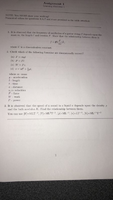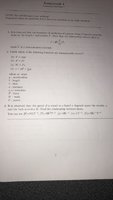You are using an out of date browser. It may not display this or other websites correctly.
You should upgrade or use an alternative browser.
You should upgrade or use an alternative browser.
Math problem
- Thread starter GSHIMMON
- Start date
D
Deleted member 4993
Guest
Please follow the rules of posting in this forum, as enunciated at:does anyone have a solution for question number 3 in the attached document.
READ BEFORE POSTING
Please share your work/thoughts about this assignment.

Looks like these are problems from physics or beginning engineering (dimensional analysis) class.
D
Deleted member 4993
Guest
Please follow the rules of posting in this forum, as enunciated at:Yes it is an engineering math problem. any ideas ?
READ BEFORE POSTING
Please share your work/thoughts about this assignment
Dr.Peterson
Elite Member
- Joined
- Nov 12, 2017
- Messages
- 16,074
Please do as we ask and show some work, so we can go from there. Problem solving often begins with being willing to try something, which leads to discovering even small facts about the problem that suggest something to try next. Sitting still and doing nothing is the way to get nothing done. Don't just ask for ideas; actively look for ideas.
What I see is that the first two equations are the only ones that involve F or P, so you can set them aside. You are given v in terms of L and T; so take the remaining two equations and try to eliminate variables other than L and T between them. You will discover the relationship you are asked for.
What I see is that the first two equations are the only ones that involve F or P, so you can set them aside. You are given v in terms of L and T; so take the remaining two equations and try to eliminate variables other than L and T between them. You will discover the relationship you are asked for.
HallsofIvy
Elite Member
- Joined
- Jan 27, 2012
- Messages
- 7,763
Dimensional Analysis: you know that speed is measured in "meters per second" or, in the notation here, "\(\displaystyle LT^{-1}\). You are told that the speed of sound in a liquid depends on the density of the liquid, \(\displaystyle ML^{-3}\), and the "bulk modulus", \(\displaystyle ML^{-1}T^{-2}\). It looks to me like this will have to involve a square root of the "bulk modulus". Do you see why?

